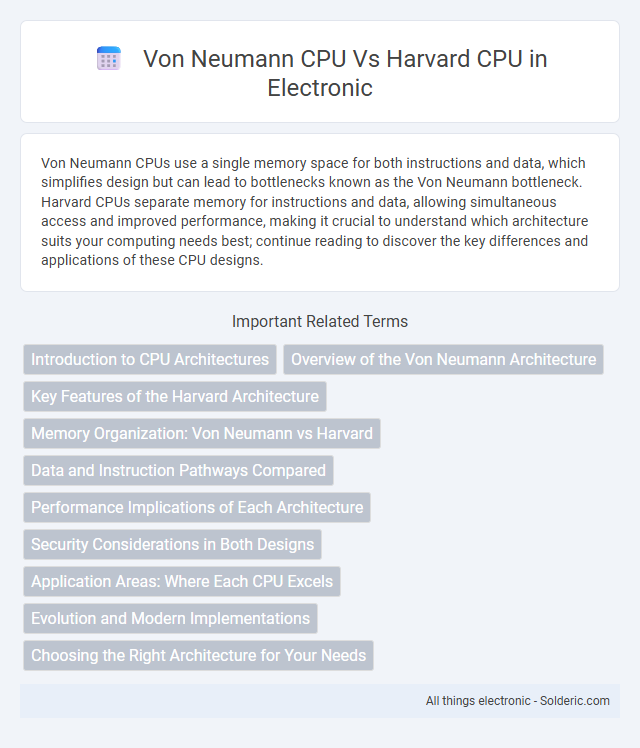Von Neumann CPUs use a single memory space for both instructions and data, which simplifies design but can lead to bottlenecks known as the Von Neumann bottleneck. Harvard CPUs separate memory for instructions and data, allowing simultaneous access and improved performance, making it crucial to understand which architecture suits your computing needs best; continue reading to discover the key differences and applications of these CPU designs.
Comparison Table
| Feature | Von Neumann CPU | Harvard CPU |
|---|---|---|
| Memory Architecture | Single shared memory for instructions and data | Separate memory for instructions and data |
| Data and Instruction Path | Single data bus for both instructions and data | Separate buses for instructions and data |
| Speed | Slower due to shared memory bottleneck | Faster with simultaneous access to instructions and data |
| Complexity | Simpler design | More complex design |
| Cost | Lower cost | Higher cost |
| Use Case | General-purpose computers | Embedded systems, DSPs |
| Instruction Execution | Sequential fetch and execution | Parallel fetch and execution possible |
Introduction to CPU Architectures
Von Neumann and Harvard CPU architectures differ primarily in their memory organization and data paths, optimizing processing efficiency in distinct ways. The Von Neumann architecture uses a single memory space for both instructions and data, which can lead to bottlenecks during execution due to sequential access. Your choice between these models influences system performance, with Harvard architecture providing faster parallel access by separating instruction and data memory.
Overview of the Von Neumann Architecture
The Von Neumann architecture features a single memory space that stores both instructions and data, enabling a unified fetch-execute cycle. This design simplifies CPU structure but can lead to the Von Neumann bottleneck, where memory access speed limits overall performance. Your system's efficiency in executing sequential instructions depends heavily on this architecture's data handling approach.
Key Features of the Harvard Architecture
The Harvard architecture features separate memory spaces for instructions and data, allowing simultaneous access that significantly improves processing speed and efficiency. This separation minimizes bottlenecks and enables parallel data and instruction fetching, making it ideal for applications requiring high-speed computing like digital signal processing. Your choice of CPU architecture impacts system performance, with Harvard architecture excelling in tasks that benefit from concurrent instruction and data handling.
Memory Organization: Von Neumann vs Harvard
Von Neumann CPU features a unified memory architecture where both instructions and data share the same memory space, enabling flexible program execution but potentially causing bottlenecks known as the Von Neumann bottleneck. Harvard CPU employs separate memory modules for instructions and data, allowing simultaneous access that increases throughput and efficiency in parallel processing. This distinct memory organization in Harvard architecture reduces latency and enhances performance in real-time and embedded systems compared to the unified memory approach of Von Neumann architecture.
Data and Instruction Pathways Compared
In Von Neumann CPU architecture, data and instructions share a single memory pathway, leading to potential bottlenecks known as the Von Neumann bottleneck. Harvard CPU architecture employs separate memory and pathways for data and instructions, allowing simultaneous access and increased throughput. This distinction enhances Harvard designs' performance in applications requiring parallel instruction and data processing.
Performance Implications of Each Architecture
The Von Neumann CPU architecture uses a single memory space for instructions and data, causing potential bottlenecks known as the Von Neumann bottleneck, which can limit processing speed due to sequential fetching. In contrast, the Harvard architecture separates instruction and data memory, allowing simultaneous access and improving throughput and overall CPU performance, especially in embedded and signal processing applications. This separation enhances pipeline efficiency and reduces latency, making Harvard architectures preferable for high-performance and real-time systems.
Security Considerations in Both Designs
Von Neumann CPU architectures present security challenges due to their unified memory, allowing data and instructions to reside in the same space, increasing vulnerability to code injection attacks. Harvard CPUs enhance security by physically separating instruction and data memory, reducing the risk of executing malicious code stored as data. Your system's security can benefit from the Harvard architecture's inherent protection against buffer overflow exploits, though it may introduce complexity in design and flexibility.
Application Areas: Where Each CPU Excels
Von Neumann CPUs excel in general-purpose computing applications such as personal computers and servers due to their unified memory architecture that simplifies programming and supports complex tasks. Harvard CPUs are ideal for embedded systems, digital signal processing, and real-time applications, where separate memory for instructions and data enables faster access and higher efficiency. Your choice depends on whether you prioritize versatility with Von Neumann or speed and predictability with Harvard architecture.
Evolution and Modern Implementations
The Von Neumann CPU architecture, characterized by a unified memory design for instructions and data, laid the foundation for early computing systems and remains prevalent in most general-purpose processors today. Harvard architecture evolved to incorporate separate memory storage and pathways for instructions and data, enhancing parallelism and speed, which is critical in embedded systems and digital signal processors. Modern hybrid CPU implementations integrate principles from both architectures to optimize performance, leveraging the Von Neumann model's flexibility alongside Harvard's efficiency in cache design and instruction pipelining.
Choosing the Right Architecture for Your Needs
Choosing the right CPU architecture depends on your specific application requirements, as Von Neumann CPUs use a single memory space for instructions and data, leading to simpler design but potential bottlenecks. Harvard CPUs separate instruction and data memories, allowing simultaneous access that improves performance in real-time processing and embedded systems. Your choice should consider factors like speed, complexity, power consumption, and the nature of the tasks your system will perform.
Von Neumann CPU vs Harvard CPU Infographic

 solderic.com
solderic.com